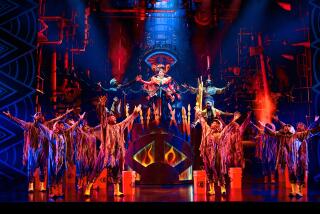A Wonderful Wizard
- Share via
In 1900, the year “The Wonderful Wizard of Oz” was published, L. Frank Baum released another book as well -- one that has long been forgotten by most of those who ever knew of it and that was utterly eclipsed many years ago by the story of Dorothy and her three comrades.
Two books in a year was not particularly unusual for Baum, who was, after all, extraordinarily prolific and whose oeuvre includes (in addition to the 14 Oz books) such lesser-known works as “The Magical Monarch of Mo” and “Queen Zixi of Ix.” His first book, published in 1886, was “The Book of the Hamburgs,” a nonfiction work for adults that was described as a “brief treatise” on the mating, rearing and management of Hamburg chickens, based on his expertise as a chicken breeder.
The book Baum published in 1900 was not a children’s book, either. But it had an effect on children in the sense that it had a small, but real, effect on Christmas as we know it in America. It was called “The Art of Decorating Dry Goods Windows,” and surprisingly enough, it was about exactly that.
Why was one of the world’s most creative novelists interested in the decorating of shop windows? In the 1880s, Baum had briefly owned and managed a department store in the small South Dakota city of Aberdeen. The store, Baum’s Bazaar, failed, a victim of the hard times depicted in the early scenes of Dorothy’s Kansas in “The Wizard of Oz” (along with a tendency to be too lenient with credit). Baum, then 34 years old, moved to Chicago.
In those days, just shortly after the advent of large plate-glass windows, there were few Christmas displays in America’s department stores. The first show windows had merely piled up goods in more or less attractive patterns.
Baum was instrumental in changing ideas about what such windows should look like. In his book, he urged window dressers to think of the show window as the stage for a unique style of urban theater. A successful window display, he argued, should not simply show commodities and their prices but should let “objects tell some legible story” to capture the eye of the “passive throng” on the city streets. Machinery, he argued, is a necessary adjunct -- the half-revolving bust, illusion windows, the vanishing lady were among his suggestions.
“You must arouse in the observer cupidity and a longing to possess the goods you sell,” he wrote. The best way to do this, he believed, was through the use of the mannequin, especially one that had been set in motion to create the illusion of life within the window’s imaginary world. The mannequin would enact a drama of desire that would captivate window shoppers. The Christmas window, which often features no commodities at all, provides this captivating story in its purest form, Baum believed, and he was central to encouraging window dressers to make the most of holidays like Easter and Christmas -- “times of joy and brightness, of full purses and generous hearts.”
At first, Baum’s career in children’s literature might seem antithetical to his work devising and promoting retail marketing strategies, but in fact the art of window dressing helped shape his literary imagination. After all, he places at the very center of his most successful fairy tale a child’s encounter with the mannequin-like Scarecrow and Tin Woodman.
It is tempting to read the Oz story as a meditation on what makes the mannequin so fascinating. Dorothy’s companions are such memorable characters because they share so sincerely the show-window dummy’s belief that the qualities that can make them truly human are in fact detachable and purchasable objects.
The familiar 1939 movie version of “The Wizard of Oz” asks us to assume that the moral is simply that you already have everything you really need to become a complete person. Yet, read from the perspective of Baum’s career in advertising, the story seems to say just the opposite: The mannequin comes to life not because he possesses the crucial object but because he feels an acute desire for it. It seems that what makes Scarecrows and Tin Men truly human is just their belief that they will always need something more than what they already have.
In the years that followed, the Oz books became enormously successful. “The Wonderful Wizard of Oz” was adapted for Broadway. (Toto, in that version, was replaced by a cow.) Baum left Chicago for Hollywood, where he proceeded to turn out sequels and created three Oz movies. Shop windows were left behind.
More to Read
Sign up for our Book Club newsletter
Get the latest news, events and more from the Los Angeles Times Book Club, and help us get L.A. reading and talking.
You may occasionally receive promotional content from the Los Angeles Times.






